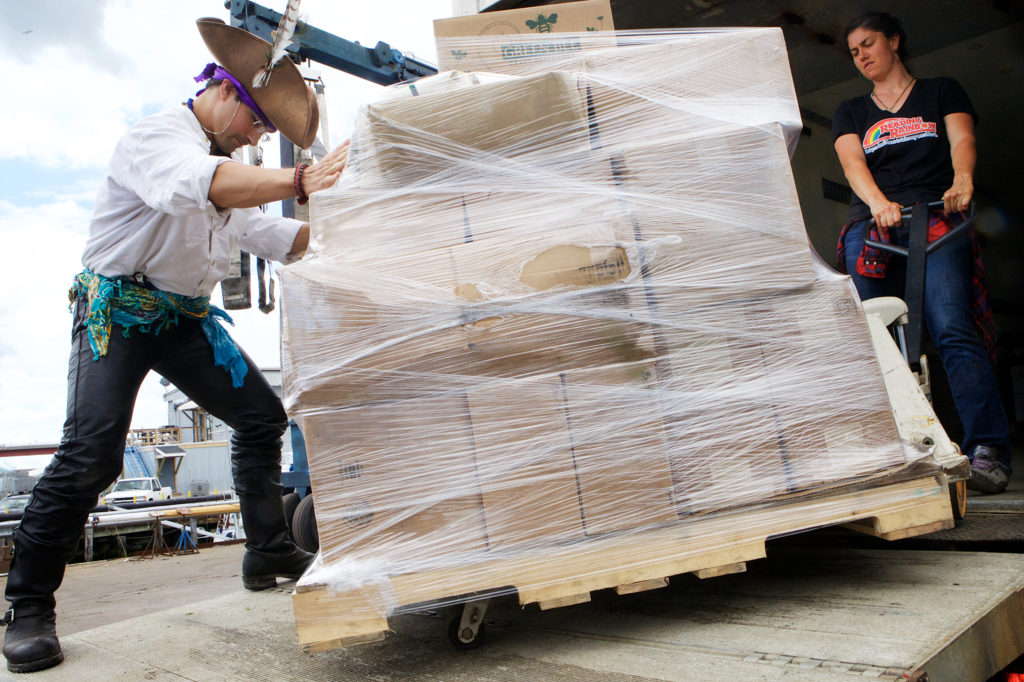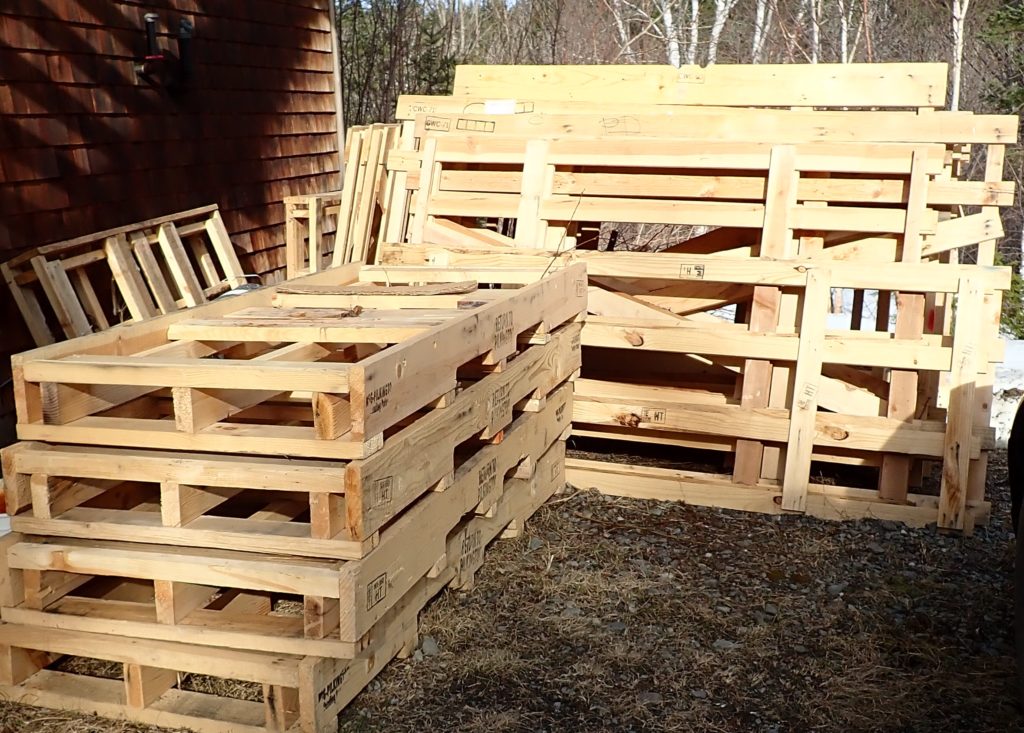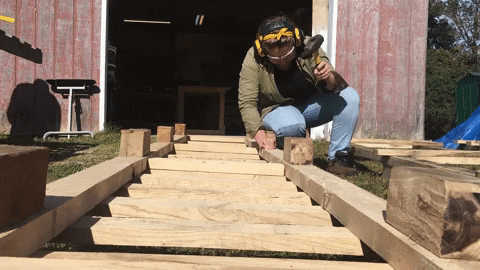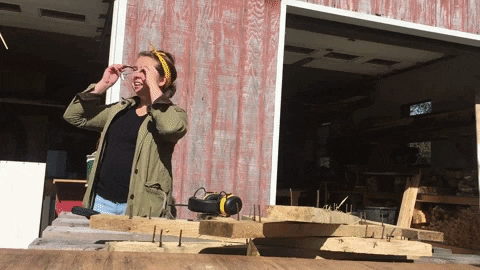I tried to make pallet wood wall art. Here’s how it went.
I see art in everything. I have a blue enamelware spoon hanging on the wall of my kitchen. A cleaned jar of salsa with a flame-licked label (spoiler alert: it was hot) sits proudly on display in my living room. When I moved to New England, I noticed a cottage industry of artisans turning shipping pallets into everything from furniture to pallet wood wall art. Situated neatly at the intersection of upcycling and artistry, I knew I had to make one for myself.

A pallet is a flat, crosshatched structure made from raw, joined wood that is used for shipping and transporting goods. Pallets are not only strong, but they can easily be lifted by machinery like forklifts, frontloaders and pallet jacks.
Since its invention in the early 20th century (pallets were first referenced in trade publications as early as the 1930s), the pallet has supplanted other forms of shipping containers, like wooden boxes and barrels. According to the National Wooden Pallet and Container Association (yes, apparently that’s a thing), an estimated 1.8 billion pallets are used to move items in the United States every day.
Though pallets can be made from plastic, paper and metal, most — around 93 percent — are made of wood. Moreover, lots of our wood goes towards making pallets. The production of pallets accounts for 43 percent of hardwood and 15 percent of softwood usage in the United States.
Pallets are also frequently reused, upcycled and recycled. According to a 2018 study published by the organization in conjunction with Virginia Tech and the U.S. Forest Service, 95 percent of pallets produced in the United States are either reused as shipping platforms or recycled into something else.
Still, that leaves tens of thousands of pallets languishing in lots. (Pro tip: small businesses are more likely to have extra pallets, as larger stores will hire third-party services to collect them). I wanted to find one of these abandoned pallets, give it new life and add it to my collection of reclaimed art.

Learning to try
Before I started working on my pallet masterpiece, I had to educate myself about the pallet problem that Pinterest won’t tell you about — specifically, with respect to health and safety.
After sampling pallets randomly from across the country (including in Portland, Maine), the National Consumers League found that 10 percent of the pallets tested were contaminated with E. coli. Three percent of the wood pallets tested positive for listeria; half of these, when further tested, contained listeria monocytogenes, one of the most virulent food-borne pathogens.
Even if you scout out pallets that haven’t been used to transport food, you may still expose yourself to toxins. Some composite wood fiber pallets are bonded using the carcinogenic urea formaldehyde.
Moreover, to avoid cross-border insect infestation, wood pallets require heat treatment or fumigation. Heat-treated pallets are safe to handle, but fumigation can be done using toxic methyl bromide (for newer pallets, though, this is unlikely — the industry pretty much stopped using that chemical about 30 years ago).
Before you bring a pallet back to your craft studio, check the numbers and letters printed on the wood. Pallets may have other stamps or symbols indicating country of origin, manufacturers location and other industry information. The website 1001Pallets has a detailed breakdown of what all these numbers and symbols mean.
First, check for the International Plant Protection Convention, or IPPC, stamp. It looks like a geometric tree, with branches on the left side and the aforementioned acronym on the right. This indicates that the pallet is safe for international shipping — that is to say, free of critters and chemicals.
Next, you want to look for the stamps indicating how the pallet was treated. “HT” stands for heat treatment, “KD” is kiln dried and “DB” is debarked, which are all safe to use. “MB” stands for methyl bromide, which should be avoided.
Already intimidated by the potential for pallet pitfalls, I knew I needed a pallet master to guide me on my journey.
A trying experience
I recruited Jason McKay, owner of Reclaim ME, and his girlfriend, Tonya McVay to help my with my pallet wood wall art project.

Reclaim ME repurposes and refinishes old furniture and upcycled wood to create everything from benches and end tables to wine racks and board games. His products are in stores throughout the Bangor area, including Tiller and Rye in Brewer and Accents Home Furnishing & Decor in Downtown Bangor, where my mom and I unknowingly perused his candle holders made from upcycled pallet feet last Thanksgiving.
Jason founded the business around five years ago after watching HGTV’s “Flea Market Flip” and thinking he could do it better. He started working with pallets about a year later.
“The material is free, usually, and it’s more unique,” he said. “You have the character of splits, knots and holes.”
More importantly, Jason used to be a woodshop teacher at United Technologies Center in Bangor, so he knows how to safely manage woodworking newbies like me.
Given that we only had an afternoon, Jason decided we would do one of his quickest and most popular pallet projects: an American flag. He and Tonya got the idea online, but while most pallet artists paint their American flags, Jason and Tonya color their flag by burning the wood with a blowtorch for a rustic, sepia effect.
We started by disassembling the pallets. The pallets that Jason uses come from Invironments in Hermon, where he works full-time in addition to crafting for Reclaim ME. The pallets are safely treated, a little longer than usual (12 feet long as opposed to the usual four-by-four) and made primarily from hardwood.

Shipping pallets are designed to withstand heavy weights and jostling, so the boards can be difficult to remove. Some of the nails and screws are also warped and bent, making them extra difficult to separate. Jason had to help me out and a few times he came out with a crowbar.
Next, we removed the nails by hammering the heads out of the board and prying them off. I tried first with a hammer, but then Jason gave me a crowbar, which was much easier (Jason warned that wood may with the force, so be as careful as you can). These tricks and techniques are the little things you learn after crafting with pallets for years, he explained.
Then came the heavy machinery. We planed the boards to an even thickness, straightened them out and halved them using a table saw (which terrified me, but I managed to escape with all my fingers). I am not sure how I would have accomplished any of this without Jason’s tools and expert guidance.
Tonya took over for the artistic elements. She helped me to categorize the boards into what would eventually become “red” and “white” based on their color and grain. She lit the blowtorch and started searing the stripes. Then, she passed it to me.
“It’s just like painting, but with fire,” I thought, in an unconvincing attempt to steady my shaking fingers.
Eventually, though, I settled into the magical experience of watching the grain emerge under the flame. Jason, Tonya and I quartered off a section to thoroughly darken and paint with stars. We used a stencil and white chalk paint — it dries faster, Jason explained — and stapled slats to the back to keep the slats together (the blowtorch made me nervous, but I loved the staple gun — go figure).

Finally, we painted the flag with a light layer spar urethane (a finish that is suitable for both indoor and outdoor display) to protect the masterpiece and make it shine.
We hung the flag outside Jason’s workshop to get a good look at the finished product.
“I think it looks great,” Jason said. “The important thing is, what do you think?”
I thought it would make a spectacular, spangled centerpiece for my home gallery of upcycled art.
My tried-and-true takeaways
Constructing pallet wood wall art is fun, but it is also challenging and potentially hazardous. Take the appropriate precautions when you are choosing your pallet and working it with whatever tools you have at your disposal. In fact, I’d recommend taking a woodworking class before striking out to upcycle pallets on your own, or finding a buddy like Jason to make art with you while ensuring that you are working safely.

